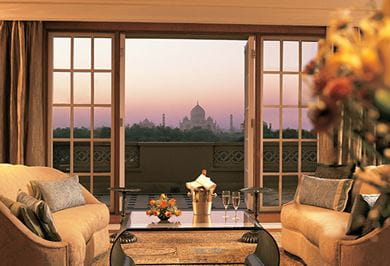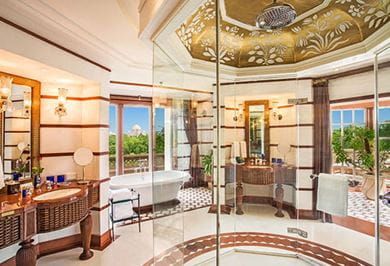







In 1992, Prince Charles, the Prince of Wales and heir to the British Throne visited India along with his wife, Diana, the Princess of Wales.
Though this was not widely-known at the time, the Wales’ marriage was in deep trouble. According to her own account (given later to many journalists including Andrew Morton), Diana felt neglected, betrayed and alone.
She retaliated by staging little PR stunts which showed her in a good light while enraging her husband. When Prince Charles made in clear that he did not have the time to visit Agra, the Princess said she would go on her own.
When she got to the Taj Mahal, which security had cleared of all visitors and tourists, the Princess sat alone on a bench, framed by the Taj which loomed majestically behind her.
That photograph was transmitted around the world within hours and made the front pages of many newspapers. It sent out the message that Diana had hoped to convey: she was a lonely, unloved, neglected wife, forced to visit the world’s greatest symbol of love all alone because her husband could not be bothered to share the experience with her.
Even today when foreign tourists arrive at the Taj, they ask to be taken to the ‘Diana bench’. Tens of thousands have since had their own photographs taken there, posing like the Princess with the Taj behind them. For them, the location echoes the most famous love-gone-wrong story of recent decades.
Which is ironic because the Taj is really the perfect symbol of love-that-never-went-wrong; of a love so overwhelming that it led another royal personage, centuries before the Wales’ had their domestic drama, to build one of the most beautiful mausoleums known to mankind.
I thought about these ironies when I went back to Agra a few weeks ago. Till the beginning of this century, the only way to see the Taj was to buy a ticket and brave the tourist hordes who had come to see one of the wonders of the medieval world.
But this time I was at The Oberoi Amarvilās, Agra, a hotel dedicated to the beauty of the Taj. It is one of the few hotels in the world (and the only one I have ever stayed in) where all the rooms face in the same direction: towards the Taj.
You get a view of the monument from every single room and because The Oberoi Amarvilās, Agra is so close to the Taj with only a patch of green separating them, you almost feel that you are sharing a garden with the Taj.
As a consequence I spent nearly all of my time at The Oberoi Amarvilās, Agra, transfixed by the view, staring at the Taj all the time. I ate most of my meals on the open balcony which let me look at Taj. When I woke up each morning I would rush to draw open the curtains so that the sunlight brought a Taj view into the room. And baths took forever because the bathtub had a terrific view of the Taj and I soaked happily in the water while taking in the view that I knew would stay with me all my life.
The thing is: I am no stranger to the Taj. I have seen it up close several times. I have toured the insides of the structure. And I have been fortunate enough to see it lit up in the moonlight for a concert by the musician Yanni.
But these have been tourist visits. You come to Agra. You check in to your hotel. You take a car and go to the Taj. You tour the complex. You come back to your hotel. And that’s it.
The wonderful thing about The Oberoi Amarvilās, Agra is that your experience of the Taj is not restricted to a single visit. The Taj is always there, every time you look out of your window. It doesn’t become a tourist site. It becomes a beautiful neighbour who is always ready to be admired.
Obviously Princess Diana had her own agenda (and all is fair in love and PR) but for the rest of us the Taj is about concentrated emotion, about how great passion can translate into great beauty.
In June 1631, Mumtaz Mahal, the favourite wife of the great Mughal Emperor Shah Jahan died during childbirth. The Emperor was heartbroken and imperial court papers record how grief-stricken he was. Later that year, he decided to commission the grand mausoleum where Mumtaz Mahal would be buried and where their love story would be celebrated.
The Taj complex was built on three acres of land. Over 22,000 stone-cutters, builders and artists were involved in the construction of the structure. The marble was local (from Rajasthan) but the jade and crystal came from China, the Turquoise from Tibet, the sapphires from Sri Lanka and the Lapis Lazuli from Afghanistan. (The stones were embedded into the marble).
The Taj took 12 years to complete though the other support buildings in the complex were still being built even after the Taj itself was ready. By one estimate, the total cost of construction came to one billion dollars in today’s money. (In that era, India was one of the world’s richest countries.)
It was - and probably still is - the most extravagantly beautiful symbol of love ever built by any man for a woman he was crazy about.
It is also the reason we remember Shah Jahan today. The Emperor never quite recovered his old spirits and happiness even after the Taj was completed.
But as Princes Diana reminded us, love and tragedy are never far apart. As Shah Jahan grew older, his son Aurangzeb revolted, dethroned him and made himself the Emperor. Shah Jahan was imprisoned in Agar Fort for eight long years. But perhaps because Aurangzeb respected the love his father had for his mother, legend has it that Shah Jahan was given a room facing the Taj so that he could gaze at it every day. (And perhaps ask the ghost of Mumtaz Mahal how their son could have turned out so wrong!)
As I looked at the Taj from my balcony at The Oberoi Amarvilās, Agra, I wondered about all the events that had surrounded it, from the imprisonment of the man who commissioned it (Shah Jahan died in custody and was buried next to Mumtaz in the Taj) to becoming so world famous that Kings, queens and emperors from all over the globe travelled thousands of miles to see it.
Beauty, and great beauty in particular, always takes your breath away. But when that beauty is combined with so many centuries of history you feel privileged to be part of the story of the Taj.
The Oberoi Amarvilās, Agra is one of the world’s greatest hotels. (Don’t take my word for it, just note how often it appears on lists of the world’s finest hotels.) And yes, judged purely as a hotel, it is outstanding in every respect. The rooms are large and spacious and fitted out with every luxurious amenity you can think of. The service is discreet but genuinely efficient. There are two restaurants and the chef is both experienced and extremely creative.
There is lots to do in Agra. You can tour Agra Fort and walk into the room where Shah Jahan was imprisoned. You can drive to Fatehpur Sikri, a whole township created by the Emperor Akbar (Shah Jahan’s grandfather) to be his capital and then later abandoned (apparently there wasn’t enough water to sustain the court) when the capital was shifted again. Fatehpur Sikri also contains the dargah, which houses the tomb of Salim Chisti, the great Sufi sanit. (The dargah actually predates the rest of Fatehpur Sikri.)
Most visitors to Agra see the Fort and Fatehpur Sikri, each of which is a marvel by itself. And certainly, if you were to stay in most Agra hotels, the Taj would be just one more marvel to rank alongside those two.
But when you stay at The Oberoi Amarvilās, Agra, the Taj becomes the whole point of the trip. You will find that you have to drag yourself away from the hotel and from the stunning omnipresence of the Taj view to go and see everything else that Agra has to offer.
After making so many trips to Agra over the years, I decided not to move out of The Oberoi Amarvilās, Agra much. The building is stunning with elegant gardens and courtyards lit by flaming torches. And the accommodation is so comfortable that I never wanted to stir.
But ultimately, I treat each visit to The Oberoi Amarvilās, Agra as a privilege because I say to myself: I will always be able to see the sights of Agra and hopefully, I will stay in other lovely hotels. But where will I ever live in the shadow of the Taj, seeing it from so close that its beauty overwhelms me?
So I spend nearly all my time on my Taj facing balcony. Because the Taj is a glorious celebration of love.
And The Oberoi Amarvilās, Agra is a celebration of the Taj.
Nita Mukesh Ambani Cultural Centre brings to the city a vibrant space for the world of music, dance, ...
I sometimes feel as though the legacy of Lord Kitchener has pursued me all of my life. I studied his ...
Should one risk a vacation in the middle of pandemic? I thought long and hard about it before decidi ...
The Mona Lisa traces back herself to her artist Leonardo da Vinci’s life at Château du Clos Lucé in ...
The Oberoi Beach Resort, Lombok has undergone rejuvenation and evolved into a destination of unrival ...
A vivid tour through the hottest Bree Street’s central reaches that we call home to the ethical food ...
The Oberoi Beach Resort, Sahl Hasheesh, offers a royal experience amidst the colourful sea life at E ...
Located at the junction of Aravali and Vindhya ranges, Ranthambhore National Park was once a private ...
William Shakespeare lived through one of the most turbulent yet thrilling era’s of English history ...
While central Melbourne has its own allure, the city’s charm lies in its diverse suburbs, each of wh ...
Adrian Rohnfelder, a photographer with a keen interest in volcanoes and adventure, shares his extrao ...
Witness the journey of a wooden instrument that broke all the records to become the backbone of Arab ...
To leap beyond imposed restrictive limits of existence is precisely what Dimpy Menon’s artworks spea ...
More than just a circus, Phare performers use theater, music, dance and modern circus arts to tell u ...
Peru is one of the peak experiences in travel. Nowhere on earth is there such an incredibly wide ran ...
The Oberoi Sukhvilas Spa Resort, New Chandigarh helps you get in touch with yourself so that you liv ...
The establishment of the British Empire greatly influenced the architecture and culture of India an ...
Complete with red sandstone fort, torch lit ramparts and ‘Haveli’ mansions, The Oberoi Rajvilās, Jai ...
Come aboard The Oberoi Zahra, Luxury Nile Cruiser for a delightful mix of luxury and history ...
The incredible Turtle Sanctuary at The Oberoi Beach Resort, Bali, is a must-visit for nature lovers ...
As part of the Beatles, arguably the most iconic rock band of all time, John Lennon and Paul McCartn ...
Oberoi Hotels & Resorts have won the hearts of many with its exquisite charm and glorious stays ...
When I work with a subject, whether it is landscape or nudes, I’m in a relationship with whatever’s ...
Portugal’s capital city of blues from the ubiquitous blue tiling adorning buildings to fado, the sou ...
My conceptual concerts initiate dialogue using various art forms. I wanted to produce works that are ...
From sticky toffee pudding and gastro pubs, to farmers markets, heritage farm meat and stalls housin ...
German art historian Sebastian Schütze, a creative master and precise in technique, captures the hum ...
The Italian art witnessed drastic movements in the period between 1850 to 1950, giving a platform fo ...
All associated with Mughal emperors, maharajas and their courts, the Al Thani Collection is a marvel ...
In the age of art as speculative and subjective, beauty can seem very much beside the point. But sta ...
Complex narratives are the peak of excitement for me. Narratives like double portraits provide stimu ...
At the helm of his eponymous brand, Fendi and Chanel, the late Karl Lagerfeld became as iconic as th ...
Essentially an attempt to replicate a beautiful representation on the canvas, I hope to convey the c ...
The Oberoi, New Delhi’s makeover is an inspiration of the contemporary interpretation of Sir Edward ...
An institution rather than a hotel, the glorious Oberoi Grand, Kolkata is the place tradition calls ...
Ginarte is a journey into beauty, a harmonic synthesis, an expression of strength and delicacy, a hy ...
Oberoi Hotels & Resorts has been ranked the world’s Best Hotel Group at the Telegraph Travel Awards ...
With more than 400 displays, Toward a Concrete Utopia: Architecture in Yugoslavia, 1948–1980, is the ...
Life of the royals in medieval England, especially the queens, was full of intrigue and scandal but ...
The Asian art scene, though young, is booming and art fairs continue to play a significant role in t ...
From ebonised Georgian bracket to 19th-century French brass carriage and the 21st-century Jaeger Le- ...
The East India Company was one of the most powerful commercial endeavours the world has ever seen, d ...
With more than 400 displays, Toward a Concrete Utopia: Architecture in Yugoslavia, 1948–1980, is the ...
The Oberoi Rajvilas, Jaipur offers an exemplary experience of luxury that transports you to the gold ...
Winner of “Middle East’s Leading Luxury City Hotel” for five consecutive years by the coveted World ...
With elegantly designed villas that offer the best of interiors to its patrons, The Oberoi Beach Res ...
On the north-west coast of Africa lies Casablanca, an ancient exotic land embraced in the sweeping s ...
The new uniforms adorning the staff at The Oberoi, New Delhi are a reflection of The Oberoi Group’s ...
Swan Lake, the iconic ballet composed by Pyotr Ilyich Tchaikovsky in the late 19th century, continue ...
The Buddha, in his many iterations across South Asia, is most exquisitely represented in gilt-bronze ...
At luxury watch brand Carl F Bucherer, design is about bringing together form and function to create ...
Queen, temptress, politician, murderer: Cleopatra remains an object of fascination for writers, arti ...
Go pedal-to-metal with the best track-ready cars unveiled at the 2018 Geneva Motor Show ...
With an enchanting combination of natural splendour, medieval heritage and modern luxury, The Oberoi ...
The Oberoi Udaivilas, Udaipur, brings together the finest in nature, luxury and impeccable service t ...
The Oberoi Amarvilas, Agra, has been voted the Top India Resort Hotel at the Travel + Leisure, USA W ...
Swiss Photographer Christian Tagliavini captures 15th and 16th-century courtly culture in a series o ...
As innovations in air travel bring the UK and Australia closer, the Kangaroo Route – once stretched ...
The Oberoi, Gurgaon offers a traveller more than just the opulence of a five-star hotel: it is a san ...
In the year 1936, legendary artist Henri Matisse executed with the utmost elegance a charcoal portra ...
The elegant suites at The Oberoi, Mumbai, provide an unrivalled experience of The Oberoi Group’s sig ...
The art collection of David and Peggy Rockefeller has garnered the highest total for any private col ...
The Oberoi Philae, Luxury Nile Cruiser takes you through the highlights of the Egyptian river on a s ...
Complementing its signature old-world charm with the finest of contemporary facilities, this Oberoi ...
Truly great experiences in life, are integral to a design sensibility that seeks to create a visual ...
Modern Indian cuisine is coming into its own, with pioneering Indian chefs like Vineet Bhatia, Gagga ...
Sailing along the River Nile aboard The Oberoi Zahra, Nile Cruiser, explore Egypt’s mystical tombs a ...
Late entertainer David Bowie’s art collection, recently auctioned by Sotheby’s, is an eclectic mix o ...
Majestic lions, magnificent wild elephants and an untouched, untainted landscape weaving together na ...
From Jean Paul Gaultier and Christian Dior to Emilio Pucci and Christian Louboutin, international fa ...
world are among the most highly coveted collectible antiques today ...
Home to the perfect confluence of nature and concrete, Al Zorah gives to luxury travellers the getaw ...
An institution rather than a hotel, the glorious Oberoi Grand, Kolkata is the place tradition calls ...
Combine the exhilaration of a jungle adventure with the relaxation of a luxurious retreat at this sp ...
From exotic varieties to beautiful native species, trees can transform your estate into your own sli ...
The East and the West might speak distinct design languages, but bring them together and a spectacul ...
In the land of the midnight sun, a quintessential family vacation is punctuated by a breathtaking ex ...
The misty Wuyi mountains in Fujian, China are home to Da Hong Pao tea, which can sell for more than ...
Award-winning architect Francis Kéré talks about his design journey and giving back to his homeland ...
In Milan, designer Arthur Arbesser and his associates work and play together, perhaps setting a temp ...
Magnates of the luxury world have been taking charitable steps into the world of European applied ar ...
The culinary offerings at The Oberoi Beach Resort, Al Zorah, reflect its vibe of simple sophisticati ...
The works of 18th-century chaser-gilder Pierre Gouthiere stand testimony to the aesthetic opulence o ...
The inner health of an organisation is as important as the external forces that influence its ascent ...
The artistic traditions of mounted porcelain and enamelling lend a whimsical air to some of the most ...
The finest works of literature can sometimes make for the finest works of cinema, and the list of fi ...
The iconic Victorian writer and social critic, seen through the eyes of his great-great-great grandd ...
Be a part of the legacy of turtle conservation on the island of Bali at this luxurious beachside hav ...
With impeccable culinary offerings, Mauritian archaeological heritage and the best location on the i ...
As The Oberoi, New Delhi revels in its newly reopened avatar, take a trip down memory lane and follo ...
Passion, craftsmanship and innovation are the defining aspects of Automobili Lamborghini’s design ae ...
As the universe of food undergoes a rapid transformation across the world, The Oberoi, New Delhi’s a ...
Fashion photography is about more than garments and labels - it is about penetrating the physical fo ...
With an artistic masterpiece by Sir Winston Churchill, The Goldfish Pool at Chartwell, recently goin ...
Balancing modernity with its centuries-old heritage, Amsterdam is a study in splendour and historica ...
Dance does not exist in a box and no rules must necessarily govern it. It is a thing of beauty, myst ...
Nestled within an impregnable valley, the “lost city” of Petra is a spectacular expression of cultur ...
Oberoi Hotels & Resorts has been ranked the world’s Best Hotel Group at the Telegraph Travel Awards ...
Ayurveda, natural healing and mindfulness together create a space of rejuvenation like no other at ...
Beginning in the national capital, make your way through these travel hotspots across India that ref ...
Leonardo da Vinci’s Salvator Mundi claimed a place in auction history recently, setting a new record ...
As the beacon of Western classical music continues to shine bright, a younger generation of musician ...
One fine April morning, 16 actors and technicians set out to take Shakespeare’s Hamlet around the wo ...
From gold snuff boxes inset with diamonds, amethysts and sapphires to ornately enamelled perfume fla ...
The written word, in conjunction with innovations, lies at the very heart of history, shaping cultu ...
August 1947: It had been more than a week since freedom had arrived and the country partitioned. But ...
The Biennale des Antiquaires culminated this year in stunning glory, only to cast its spell afresh n ...
Over the years, I must have observed and recorded the behaviour of at least 125 tigers in Ranthambho ...
The ancient science of Ayurveda tells you how best to enhance your beauty and nourish not only your ...
The gleaming, fluorescent-green topsides of the superyacht Inouï may scream luxury at the Maxi Yacht ...
The world is changing and it is not changing to the benefit of the manufacturers and retailers of so ...
This season, drive in style with these uber-luxurious four-wheeled debutantes ...
The phrase, ‘home is where the heart is’ acquired a new meaning for the children at SOS Children’s V ...
India’s finest private collections of classical Indian art mindfully preserve its creative heritage ...
Make memories last forever by taking your most cherished photographs beyond the frame and photo albu ...
With breathtaking views, luxurious rooms, rejuvenating spa therapies and a state-of-the-art golf cou ...
Seamlessly weaving together traditional elements of Indian architecture, aesthetically landscaped ga ...
Exquisite collectibles going under the hammer are letting connoisseurs acquire a little bit of histo ...
Coming to India in 1865 as the principal of an art school, John Lockwood Kipling made an invaluable ...
When travelling along the path of kings and queens, The Oberoi Hotels & Resorts offer a palatial pla ...
For luxury travellers, the sky is the limit, quite literally, as a gourmet open-air meal at the base ...
From 18th-century ormolu clocks framed by candelabra to enamelled 19th-century timepieces, mantel cl ...
The Emirate of Ajman is home to The Oberoi Beach Resort, Al Zorah, a modern architectural masterpiec ...
The last queen of France was a great commissioner of beautiful things, and several of the shops she ...
From exclusive garments manufactured in Italy to style inspirations drawn from art, this is what the ...
A new facet of Pablo Picasso’s artistic repertoire is taking over the international art market his c ...
Every bottle of vintage wine has a story to tell. We give you the narratives behind five of the fine ...
In the universe of Modern art, rivalry is a complex dynamic that enables one artist to be influenced ...
A story is conditional – it is a matter of perception and might not always be, subliminally or even ...
From unique water and land activities to certified diving courses, desert tours and more, this all-s ...
Enrich your stay in Ranthambhore at this opulent jungle resort, in close proximity to nature, yet ne ...
With performative nuances and provocative appeal, Western classical music has evolved into a complex ...







Second child until maximum age of 12 years will be accommodated in the same room at additional supplement. The additional amount is not included in the room price mentioned and shall be payable at the hotel during check-out.
400 AED (including tax)
250 AED (including tax)





